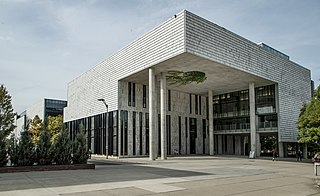The Foresight Institute (Foresight) is a San Francisco-based research non-profit that promotes the development of nanotechnology and other emerging technologies, such as safe AGI, biotech and longevity.

Nanotechnology, often shortened to nanotech, is the use of matter on atomic, molecular, and supramolecular scales for industrial purposes. The earliest, widespread description of nanotechnology referred to the particular technological goal of precisely manipulating atoms and molecules for fabrication of macroscale products, also now referred to as molecular nanotechnology. A more generalized description of nanotechnology was subsequently established by the National Nanotechnology Initiative, which defined nanotechnology as the manipulation of matter with at least one dimension sized from 1 to 100 nanometers (nm). This definition reflects the fact that quantum mechanical effects are important at this quantum-realm scale, and so the definition shifted from a particular technological goal to a research category inclusive of all types of research and technologies that deal with the special properties of matter which occur below the given size threshold. It is therefore common to see the plural form "nanotechnologies" as well as "nanoscale technologies" to refer to the broad range of research and applications whose common trait is size.

Proteolysis is the breakdown of proteins into smaller polypeptides or amino acids. Uncatalysed, the hydrolysis of peptide bonds is extremely slow, taking hundreds of years. Proteolysis is typically catalysed by cellular enzymes called proteases, but may also occur by intra-molecular digestion.
Jeff Smith or Jeffrey Smith may refer to:
The National Nanotechnology Initiative (NNI) is a research and development initiative which provides a framework to coordinate nanoscale research and resources among United States federal government agencies and departments.
Sir Mark Edward Welland, is a British physicist who is a professor of nanotechnology at the University of Cambridge and head of the Nanoscience Centre. He has been a fellow of St John's College, Cambridge, since 1986 and started his career in nanotechnology at IBM Research, where he was part of the team that developed one of the first scanning tunnelling microscopes. He was elected as the master of St Catharine's College, Cambridge and took up office on 1 October 2016.

George David William Smith FRS, FIMMM, FInstP, FRSC, CEng is a materials scientist with special interest in the study of the microstructure, composition and properties of engineering materials at the atomic level. He invented, together with Alfred Cerezo and Terry Godfrey, the Atom-Probe Tomograph in 1988.

The National Research Council of Canada Nanotechnology Research Centre is a research institution located on the University of Alberta main campus, in Edmonton, Alberta, Canada. Its primary purpose is nanoscience research.

The Marcus Nanotechnology Building (MNB) is a Georgia Institute of Technology facility. The building was constructed on the site of the Electronics Research Building, the former home of GTRI's Information and Communications Laboratory. It was opened on April 24, 2009, as the Marcus Nanotechnology Research Center, a name it held until October 2013.
The impact of nanotechnology extends from its medical, ethical, mental, legal and environmental applications, to fields such as engineering, biology, chemistry, computing, materials science, and communications.
The Feynman Prize in Nanotechnology is an award given by the Foresight Institute for significant advances in nanotechnology. Two prizes are awarded annually, in the categories of experimental and theoretical work. There is also a separate challenge award for making a nanoscale robotic arm and 8-bit adder.

The Ryerson & Burnham Libraries are the art and architecture research collection of the Art Institute of Chicago. The libraries cover all periods with extensive holdings in the areas of 18th-, 19th- and 20th-century architecture and 19th-century painting, prints, drawings, and decorative arts. A variety of materials important to scholarly research includes architects' diaries, correspondence, job files, photographs, sketchbooks, scrapbooks, articles, transcripts, and personal papers.
Discovery Park is a 40-acre (160,000 m2) multidisciplinary research park located in Purdue University's West Lafayette campus in the U.S. state of Indiana. Tomás Díaz de la Rubia, an energy and resources industry executive who also spent a decade as a top scientist and administrator at Lawrence Livermore National Laboratory, serves as Discovery Park's Vice President.
The Proteolysis MAP (PMAP) was an integrated web resource focused on proteases. Its domain now links to a scam/spam browser extender.

Angelika Amon was an Austrian American molecular and cell biologist, and the Kathleen and Curtis Marble Professor in Cancer Research at the Massachusetts Institute of Technology (MIT) in Cambridge, Massachusetts, United States. Amon's research centered on how chromosomes are regulated, duplicated, and partitioned in the cell cycle. Amon was elected to the American Academy of Arts and Sciences in 2017.
The International Institute for Nanotechnology (IIN) was established by Northwestern University in 2000. It was the first institute of its kind in the United States and is one of the premier nanoscience research centers in the world. Today, the IIN represents and unites more than $1 billion in nanotechnology research, educational programs, and supporting infrastructure.

The Sri Lanka Institute of Nanotechnology is a Sri Lankan research institute specialising in the field of nanotechnology. It was incorporated in 2008 as a public-private partnership between the Government of Sri Lanka and five private companies, and is notable for being the first public-private research institute in the country.

The architecture of Columbus, Ohio is represented by numerous notable architects' works, individually notable buildings, and a wide range of styles. Yost & Packard, the most prolific architects for much of the city's history, gave the city much of its eclectic and playful designs at a time when architecture tended to be busy and vibrant.








